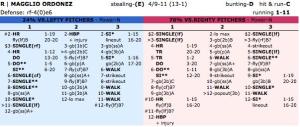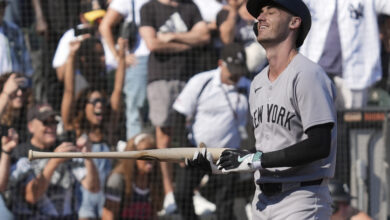
12 Years Later, Does Moneyball Still Have an Influence?
With the recent passing of the trade deadline, I’ve been doing a lot of thinking about all the different types of strategies and moves made by different GM’s around the league. There were some, like Toronto’s Alex Anthopoulos, who went for broke by trading away all their prospects for one shot at the playoffs. Others, like Rubén Amaro, Jr., began selling some of their best players to acquire prospects. San Diego’s AJ Preller did nothing for a team overwrought with overweight contracts and out of the running based on talent that he likely overvalued.
In this day and age, it’s very rare to see a trade of major leaguer-for-major leaguer like I did in my childhood. The biggest reason for that, I think, has been Michael Lewis’s seminal book, Moneyball. Published in 2003, the text has influenced how GM’s do their job in an uneven market to evaluate talent and build a ballclub in the 21st-century. Lewis wrote the book after following around O akland General Manager Billy Beane, who had put together winning teams with minimal payroll. Lewis wanted to see how the A’s were doing it by looking at how Beane and his staff evaluated and selected talent in the 2002 MLB draft.
akland General Manager Billy Beane, who had put together winning teams with minimal payroll. Lewis wanted to see how the A’s were doing it by looking at how Beane and his staff evaluated and selected talent in the 2002 MLB draft.
I think a lot of the book has been misinterpreted, specifically how Beane evaluated talent and built his team. Twelve years after the release of the book, many people — in and out of baseball alike — don’t truly understand what the GM in the 21st-century does or is supposed to do. First, the book is not the manual some perceive it to be. Second, there is more than one way to be a General Manager and acquire talent.
One of the key concepts in the book is to use statistics to evaluate talent across all levels. The first people to get ahold of statistics and truly begin to analyze the metrics of baseball were the people behind Strat-O-Matic. Based on statistics and tendencies of baseball players, the game was developed in the early 1960’s and became popular across the country. Every kid who loved baseball in the 1960’s and 1970’s couldn’t wait until the advertisement appeared in the classified section of Sports Illustrated or The Sporting News. You would then cut it out and mail it in to order your new set of cards for that year.

The Society for Baseball Research (SABR from which sabermetrics comes) began in 1971. They used many of the same terms and stats as Strat-O-Matic, and we’ve seen an increased trend toward statistical application in the real-life game ever since. But this shift has not been without its growing pains and misunderstandings.
To me, the biggest misnomer and probably the most highly underplayed aspect of moneyball (which is to say the concept and not the book itself) is that of Bill James’ statistical analysis book called The Baseball Abstract. Here is just a sample from James’ highly influential book on evaluating talent.
In 1988, James wrote:
1. Minor league batting statistics will predict major league batting performance with essentially the same reliability as previous major league statistics.
2. Talent in baseball is not normally distributed. It is a pyramid. For every player who is 10 percent above the average player, there are probably twenty players who are 10 percent below average.
3. What a player hits in one ballpark may be radically different from what he would hit in another.
4. Ballplayers, as a group, reach their peak value much earlier and decline much more rapidly than people believe.
5. Players taken in the June draft coming out of college (or with at least two years of college) perform dramatically better than players drafted out of high school.
6. The chance of getting a good player with a high draft pick is substantial enough that it is clearly a disastrous strategy to give up a first round draft choice to sign a mediocre free agent. (see note #1)
7. A power pitcher has a dramatically higher expectation for future wins than does a finesse pitcher of the same age and ability.
8. Single season won-lost records have almost no value as an indicator of a pitcher’s contribution to a team.
9. The largest variable determining how many runs a team will score is how many times they get their leadoff man on base.
10. A great deal of what is perceived as being pitching is in fact defense.
11. True shortage of talent almost never occurs at the left end of the defensive spectrum. (see note #2)
12. Rightward shifts along the defensive spectrum almost never work. (see note #2)
13. Our idea of what makes a team good on artificial turf is not supported by any research.
14. When a team improves sharply one season they will almost always decline in the next.
15. The platoon differential is real and virtually universal.
A lot of James’ influence has been brushed aside in recent years and the statistics quoted by Beane and his staff have become the norm for most GM’s in the league. So while James’ book is actually the foundation for Beane’s analysis, many have attributed these moneyball concepts to the Oakland exec. Misplaced credit notwithstanding, some GM’s have cut back their scouting departments in the wake of this revolution to focus more on the statistical nature of the game.
But make no mistake, in-person scouting is more important than ever. At the MLB level today, talent evaluation should be a mixture of statistics and actual scouts who are at a ballpark watching live action. I think if you believe the lesson of Moneyball is that you should just use numbers to evaluate talent, you’re missing the point completely. Several scouts always tell me the only two things they need to know about a pitcher are movement and location. You can tell more about a pitcher by the ugly swings he gets rather than the radar gun.

The unintended consequences of Moneyball have been a reliance on statistics to evaluate performance. As GM’s get ready to make trades, I am pretty sure that they look at the statistics; they should be looking at the scouting reports as well. One should not outweigh the other. Rather, they should both be used to form a balanced opinion. This is what Cubs Director of Pro Scouting Joe Bohringer stated at the 2014 Cubs Convention that the Cubs strive to do. In-person data is just as important as metrics to show development or trends of a player over time.
The scout should be able to tell you whether a hitter is vulnerable to an inside fastball or a pitch down and away. The scout should be able to tell you whether a pitcher’s 95 mph fastball is a straight line or darts back-and-forth across the horizon.
After more than a decade, Moneyball is still affecting the game. Its influence on the future, however, is uncertain. For example, one of the statistics used in the book, OPS, has been downplayed in recent years because it is a combination of two other stats: on-base percentage plus slugging percentage. The range of that statistic could be heavily influenced by one of the base numbers being extremely high, thus unfairly influencing a combined stat.
For example, one player could have a high OBP of .483 and a slugging percentage of .510, while another player has a line of .310 and .580 – those two stats combos are very similar, but these are two very different ballplayers. That’s not what the stat was intended to do.
Going forward, I think if teams look at how they evaluate talent that they want to draft, talent in their system, and talent in other teams’ systems, they can’t solely rely on statistics as a measurement of player performance. Moneyball, though important throughout its initial decade of publication, may have been misapplied in terms of how teams should evaluate talent. I don’t think the book was intended to be a manual on how to be a general manager in the 21st-century. I think its intention was to evaluate how Billy Beane did it on a shoestring budget, hence the use of “money” in the title.
Take the Cubs, for example: they have their own stats department, major and minor league scouting departments, and a variety of amateur scouts. You can look at the St. Louis Cardinals/Houston Astros hacking scandal to see how important data — specifically the evaluation of it — is to an organization.
Today’s GM’s are running their teams in a variety of different ways. The Dodgers’ Andrew Friedman did things like Beane for years when he was with Tampa Bay; now that he’s in Los Angeles, he’s flipping out dollar bills like there’s no tomorrow. Some execs still go for big free agents and big contracts while others don’t. Some hoard prospects while others rely on “devil-magic,” coaching, and development.
It should be interesting to see how the influence of the book plays out over the next decade, which includes how it’s misapplied as much as it is applied. To be sure, money will always have an influence over the game, but you still have to evaluate talent correctly to win.
Writer’s Note
Thanks to Ryan Davis’ picture of the book to get me thinking on this.
Thanks, Ryan!
Went digging through some boxes for an old book to read on my trip, and what do I find? pic.twitter.com/IMn1hAGi7l
— Ryan Davis (@Ryan_Davis17) August 1, 2015

